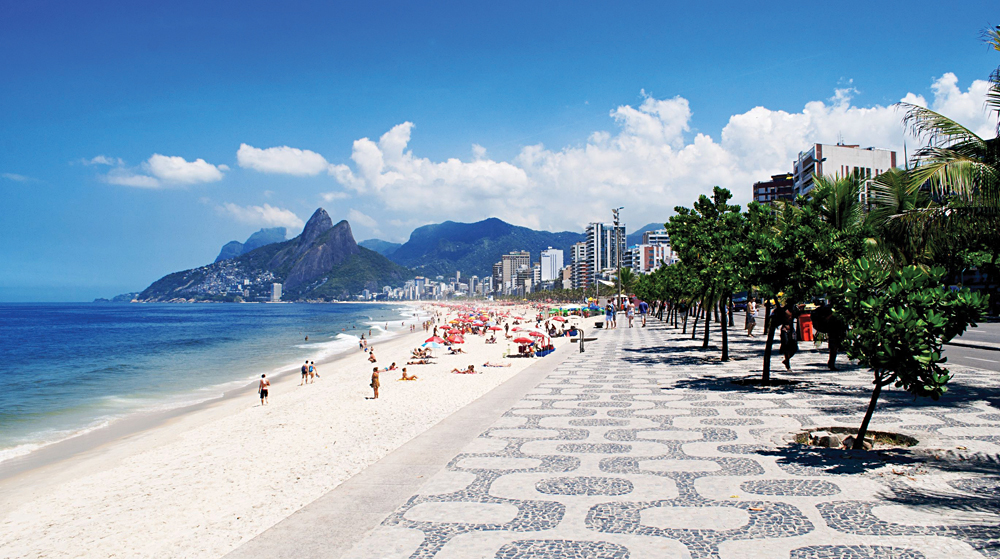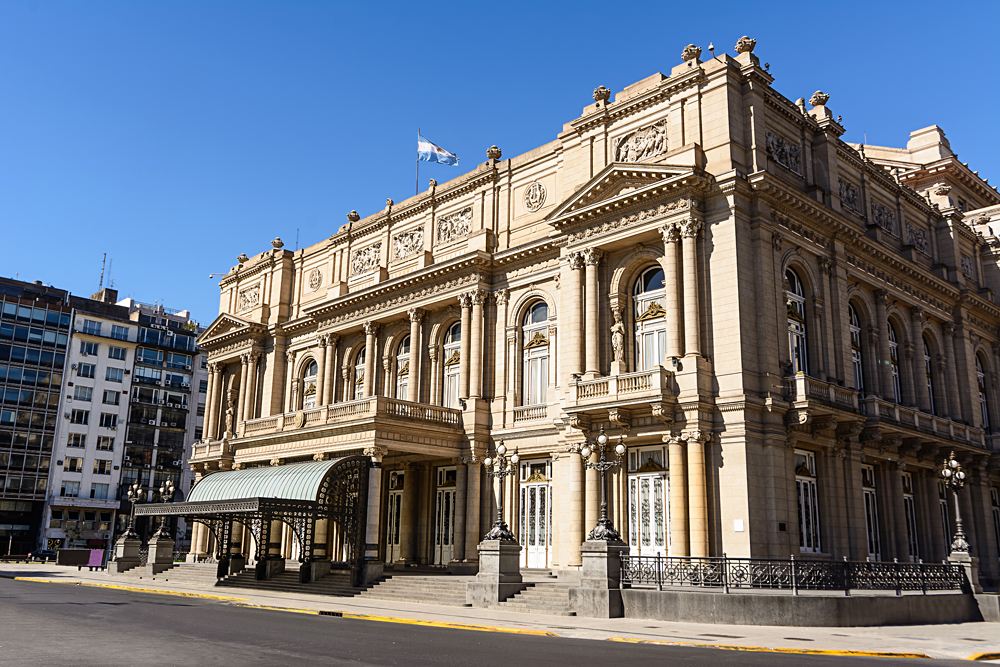I’m in the air, on my way to Buenos Aires from Iguazu Falls, when the English traveller in the neighbouring seat admits to having skipped the Brazilian side of those mighty waters. "We didn’t think the visa was worth the extra money,” he explains, "just for one day on the other side." He has a point, though I’m cringing at the thought of coming all this way only to miss the panorama that can only be seen from the Brazilian side. Many visitors, including myself, choose to take the classic route linking Rio de Janeiro to Buenos Aires, and for many, these two cities come to symbolize what Brazil and Argentina are all about. My trip also included a stop in Sao Paulo, a city I will happily defend against any and all naysayers. Hungry for more, perhaps my next trip will include visits to Mendoza, Salvador, Brazil’s northern beaches, Patagonia... the list is endless in these massive countries. So, since I can’t speak for all of Brazil or Argentina, I’m going to talk about Buenos Aires and Rio. Specifically, their many differences, a few similarities, which is the better city for first timers, and where to spend extra time on your South America trip, if you have it.
Climate and Weather
When it comes to weather, Rio can feel like paradise at any time of year. Rainfall more than doubles in the heat of summer, but storms are often over quickly. The winter months are relatively dry and rarely dip below 15c/60f. Weather in Buenos Aires is more seasonal, with mild, dry winters. Summers routinely skim 30°C/86°F, while winters usually bottom out just below 10°C/50°F. In short, there’s not a huge difference, but Rio’s climate is, appropriately, more suited to a beach vacation.

Big Sights and City Icons
Rio’s two biggest attractions stare at each other across the city, marking the entrance to Guanabara Bay from the Atlantic Ocean. Christ the Redeemer stands atop the Corcovado, giving his blessing to the Marvelous City, while Pao de Acucar, Sugarloaf, leans toward the sea. More than anything else though, Rio is a beach city, and particularly in summer, it can seem as if life revolves around as praias. A major revitalization project has also brought Rio’s harbourfront to international attention, with new attractions such as the Museum of Tomorrow, and the world’s largest mural.

To be honest, iconic, "big ticket" attractions aren’t what Buenos Aires is about. This is an urban explorer’s town, with neighbourhoods that feel like a treasure chest of fascinating museums and galleries, cute cafes and stores, and the kind of enchanting architecture that rewards aimless wandering. There are also some cultural highlights, including Teatro Colon opera house, and La Recoleta Cemetery. Soccer fans also won’t want to skip La Bombonera, home of the famous Boca Juniors. Still, the only real "bucket list" item in Buenos Aires is the city itself, which is enough.
Attitude and Energy
The great differences between Buenos Aires and Rio de Janeiro make combining them a great way to put some variety into your South America trip. But the two do have some important things in common.
You might expect Rio’s culture to be all about the beach, but that’s only half its story. Brazil’s capital until 1960, Rio was for many years "the big city," attracting artists of every discipline from all regions of Brazil. You can really see evidence of this in the historic Santa Theresa district, and Lapa, the city’s main nightlife area where the sounds of samba were first defined. The area is closely tied to the history of samba today, having served as a haven for cultural radicals throughout Brazil’s history. You can still hear it in the music that pours through Lapa clubs. Of course, the energy of Carnival season is a party all its own! While the holiday is celebrated across Brazil, in Rio, it’s taken very seriously, with great prestige and public adoration showered on winning samba schools. In short, this is a city that celebrates life, the beach, and its natural beauty on a daily basis, and you’ll see this reflected in many ways.
Buenos Aires is often said to be the most European of South America’s cities, which isn’t surprising when you consider its history of Italian immigration. It has a somewhat more reserved atmosphere than Rio de Janeiro, though certainly not an unfriendly or dispassionate one. Portenos are a stylish bunch, while their northern neighbours tend to dress down in the tropical heat (and to deter thieves). In Buenos Aires, you’re also more likely to get into a passionate discussion over dinner about the latest films, music, art, literature, and perhaps more than anything else, the theatre, a local obsession. Then, after about 1am, it’s time to go out! After all, you didn’t sit down to dinner until at least 10pm, did you? Dinner starts much earlier in Rio, usually around 8pm.

Football/soccer is practically the state religion in both countries, and the two are (friendly) arch rivals. If you want to talk football, it’s probably best to switch your team allegiances when you cross the border!
Getting Out in the Great Outdoors
No prizes for guessing Rio’s edge here! Don’t be surprised if it’s love at first sight when you glimpse "The Marvelous City." With the mountains of the Tijuca rainforest rising at its centre, and glorious stretches of white beach lining its southern coast, no city on earth has a natural setting quite like Rio de Janeiro. Still not convinced? Be sure to catch at least one sunset from the rocks of Arpoador, and feel free to join in when all of Ipanema Beach applauds Mother Nature for the end of yet another beautiful Rio day. If you have time, head into Tijuca National Park and explore some of the hiking trails, or simply bike around the perimeter of Rodrigo de Freitas Lagoon. And, oh yes, rumour has it there are some nice beaches in this town, somewhere...
I’m not breaking the news by telling you Buenos Aires is more of an indoor city. Still, Portenos like to stay active (or need to – see food), so Buenos Aires is full of big, beautiful parks, particularly in the fashionable Palermo district. Perhaps the city’s crowning achievement when it comes to nature is the Costanera Sur Ecological Reserve. A natural buffer of green space between the city and Rio de la Plata, the reserve offers over 860 acres of tracks ideal for walking, jogging, or biking. On a Sunday, it’s one of the city’s favourite places to play, while tourists crowd into San Telmo’s markets. For the ultimate Sunday out in BA, have breakfast in San Telmo, then browse the market to your heart’s content before heading over to the reserve for the afternoon. A variety of food vendors will also let you sample some of the city’s delicious street treats such as choripan (did I mention food?).
Feeding Your Cultural Appetite
With due respect to Rio, there’s no contest. Portenos are almost as mad for the theatre as they are for football. The theatres along Corrientes Avenue release a flood of culture vultures every night, many of whom will cap off the show with a very traditional slice of Argentina’s famous pizza. Cinemas are just as full, while Palermo and Recoleta boast half a dozen wonderful galleries including the Museum of Fine Arts, the Museum of Decorative Arts, and the superb Latin American Art Museum. A stone’s throw from each of them is Floralis Generica, an eye-popping steel flower that opens and closes with the sun. A night out at the opera, symphony, or ballet is an occasion that demands dressing up. Even the city’s most famous book store, El Aterno Gran Splendid, occupies a former theatre, and is widely praised as the world’s most beautiful book store.

Of course, here’s still plenty for culture lovers to see, do, and experience in Rio, on their South America trip. Cinelandia is the home of the once glamorous picture houses that surround Praca Floriano Peixoto. In the early 1900s, this was the "Broadway" of South America, at least for film. Many of the theatres are now sadly closed, but in their place are art galleries, cafes, bars, restaurants, and in recent years, revived cinemas. So it’s possible Cinelandia may one day return to fire Rio’s imagination again. Even if it doesn’t, Lapa, with its rich samba heritage isn’t far away, and if you head towards the bay, you’ll find eye-popping museums such as the Centro Cultural Banco do Brasil, the Rio Museum of Art, and the otherworldly Museum of Tomorrow, a science museum with a special focus on climate change.

If you really want to immerse yourself in the local culture of either city, attend a milonga in Buenos Aires to try out your tango heels, or visit a samba school in Rio on rehearsal night. Salgueiro and Mangueira are two big schools eager to welcome visitors, provided they’re eager to join in!
Food, Food, Cocktails, Wine, and More Food...
As someone who will happily eat their way through almost any destination without shame, I couldn’t wait to try the local specialties in both cities, and they did not disappoint!
Brazilian cuisine can be almost anything you want it to be. A typical Carioca lunch in the city starts with rice and black beans, and is then enhanced with whatever meats and vegetables you pluck from the buffet. The plate is then charged by weight. In multicultural Brazil, the variety on offer is endless, but if Rio has a signature dish, it’s feijoada, a mix of black beans, and meats, usually pork of various kinds. Be sure to try the national cocktail, the caipirinha. You’ll find them available every few metres along Copacabana and Ipanema beaches, but go easy. They’re strong! Then, there’s acai, a deliciously sweet, yet low calorie berry snack native to Brazil. I’d seen acai products many times before back home, but the high energy snack is ubiquitous here, not to mention much cheaper. It proved a great way to recharge those sightseeing batteries in Rio! Then, there’s the food in Buenos Aires. Oh, boy, is there the food in Buenos Aires! I’m a little biased, as I had the privilege of indulging in The Argentine Experience, an interactive dinner which allowed me to sample several courses of Argentina’s staple foods and snacks, along with a variety of wine and mouth-watering steak!
Elsewhere, Italian immigration has played a major role in shaping Argentine cuisine. In short, you’ll find terrific pizza and ice cream almost everywhere you go. There is also the heavy, but oh-so-good milanesa, best served as Milanesa de la Napolitana. Like a beef schnitzel covered in tomato-based sauce, ham, and cheese, this almost rivalled the classic Argentine bife de chorizo as my favourite Buenos Aires staple. Blasphemy, I know. Tasty, tasty blasphemy.

The Better Choice for First Timers
Many Globetrotters choose either Argentina or Brazil for their first South America trip, so for some, the question becomes whether Buenos Aires or Rio de Janeiro is more "first-timer" friendly. It depends on what type of traveller you are, but most North Americans will find Buenos Aires easier. It’s a bit cheaper, and simpler to navigate, since the transit system covers the city well. The use of Spanish rather than Portuguese (don’t assume either Argentineans or Brazilians speak both, most don’t) gives many North Americans an instant advantage as well, which of course reverses if you speak Portuguese! With the exception of a few neighbourhoods like La Boca, Buenos Aires is also safer, particularly during the day. In short, if you’ve travelled in Southern Europe, you probably already have most of the tools and tricks you’ll need for hassle-free travel in Buenos Aires. Many tourists find Rio a more challenging city for several reasons. The crime rate is undeniably higher, and while much of that is located far from where tourists venture, some extra precautions to avoid petty theft (which we’ve talked about several times on this blog) are still recommended for exploring the Zona Sul and Centro, aka downtown, which should be avoided at night. Even in daylight, Rio has an edgy quality that will excite some travellers while unsettling others. The city’s mountainous geography also makes it more challenging to navigate. Its metro is a handy link between the Zona Sul and Centro, but the limited stations are some distance from many popular attractions and nightlife districts. You’ll definitely need cabs or Uber at night, and a certain amount of streetwise gumption during the day.

With that said, Argentina has its own petty "challenges" for travellers. One that almost drove me crazy? The cash society that makes it bizarrely difficult to get cash! ATMs are only found inside banks, which are only open during specific hours. There are often queues for the limited number of machines, which dispense a limited amount of cash per day, stinging international visitors a hefty fee each time. This might not have been a problem, had the B&B I stayed at not also insisted on being paid in cash! Thankfully, restaurants, cafes, and museums tend to be far more plastic-friendly, at least in Buenos Aires. In Brazil, credit cards are accepted virtually everywhere, and ATMs aren’t hard to come by either, though to avoid skimming, you should try to use one in your hotel, a bank, or a shopping mall, rather than a random one on the street. Oh, and disregard anything you read about the "blue rate" on Argentina’s currency. This was abolished two years ago, so it’s best to exchange and withdraw money through official channels.

And the Winner Is...
Kidding. There’s no way to rank one of these incredible cities over the other. They’re just too different. But to summarize:
Choose Rio de Janeiro for:
- Beach and outdoor activities
- Natural beauty
- Bucket list sights like Christ the Redeemer and Sugarloaf
- A grittier urban adventure
- Carnival and the street life it brings
Choose Buenos Aires for:
- Museums and galleries
- Love of culture and theatre
- Great food and wine
- A taste of Europe in South America
- Accessibility and ease of exploring on your own
Both cities for:
- Great weather
- A fascinating history
- Endlessly energetic nightlife
- Beautiful people
Still can’t decide? Good. Don’t. Your Iguassu Falls, Buenos Aires, and Rio adventure is waiting so you can experience both in all their splendour. Not to mention both sides of the falls.
Christian’s first globetrotting adventure saw him get lost exploring the streets of Saigon. Following his nose to Asia’s best coffee, two lifelong addictions were born. A freelance writer and novelist, Christian’s travels have since taken him around his native Australia, Asia, Europe, and much of North America. His favourite trips have been through Japan, Spain, and Brazil, though with a love of off-beat, artsy cities, he’ll seize any opportunity to return to Paris, New York, or Berlin.
Get Inspired
Travel Stories to Inspire You.
Newsletter
Unlock Even More
Sign up to our newsletter to unlock travel Specials, Inspiration, and Expert Guides right to your inbox.




